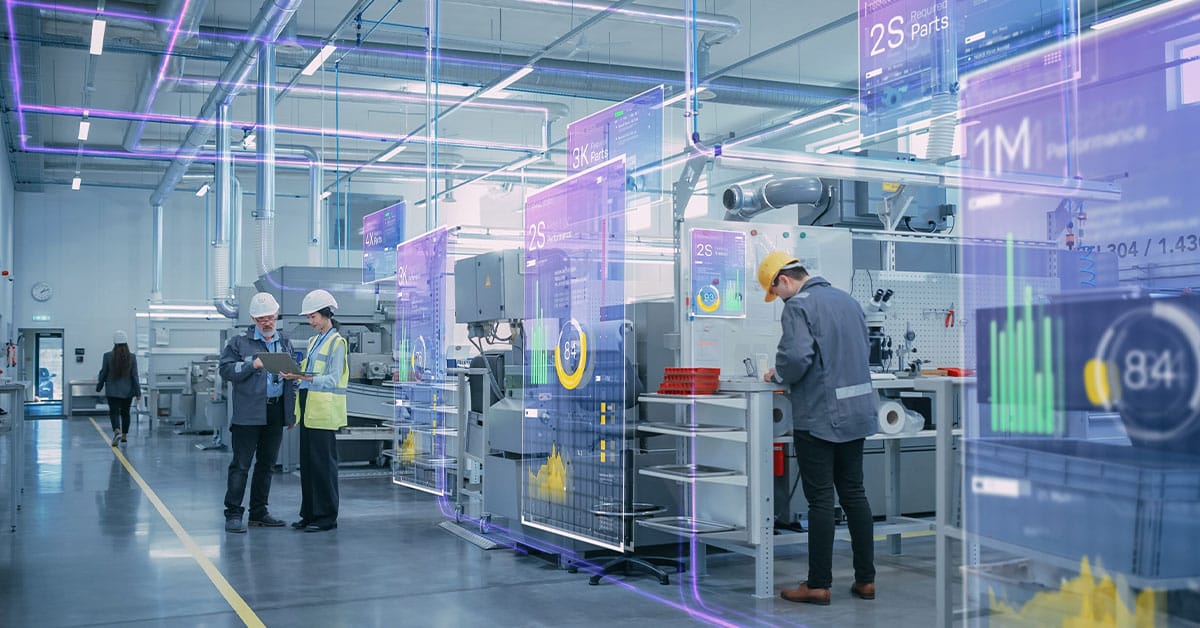In today’s increasingly competitive manufacturing landscape, asset management is more important than ever. Effective asset management can improve performance, reduce costs and significantly extend the lifespan of equipment.
With all of these potential benefits, rampant challenges such as disorganized inventory, multiple vendors and urgent parts needs make implementing effective asset management programs an uphill battle for most manufacturers.
Through AI’s predictive capabilities, it is revolutionizing asset management like never before, primarily in the arena of factory maintenance. Whether it’s short-term catch up or long-term maintenance relief, the key issue AI addresses is downtime.
Let’s dig deeper into how AI can be harnessed for transformative industrial asset management and in the manufacturing industry as a whole.
The role of AI in asset management
Artificial intelligence (AI) is quickly becoming a game changer in the industrial asset management sector. AI’s ability to analyze and process vast amounts of data is helping industries streamline operations, improve efficiency and maintain optimal asset conditions.
Predictive Maintenance
One of the key roles of AI today is predictive maintenance. Through advanced AI and machine learning algorithms potential equipment failures can be forecasted before they occur. This is achieved by analyzing both historical and current machine performance and operational data allowing industries to anticipate issues well in advance by using AI. Rather than waiting for an expensive piece of equipment to break and then servicing it, performing preventive maintenance can provide massive cost savings and time savings over the long term.
Inventory management

AI asset management also plays an invaluable role in inventory management. Through smart sorting and predictive analytics AI ensures optimal levels of stock, which reduces downtime and saves on costs.
Lifecycle management
AI is instrumental in all stages of industrial asset management — from the acquisition of new equipment, its use, maintenance and finally its decommissioning. This holistic view of operations allows producers to maximize both productivity and efficiency, significantly improving the current plant life cycle management processes in the industry. If we take an honest look at the likely path forward, we’ll likely agree that AI lifecycle management systems are the future.
Improving overall equipment effectiveness
Artificial intelligence asset management is great at pinpointing inefficiencies across production processes. By analyzing complex data patterns AI enhances overall equipment effectiveness which directly impacts the bottom line.
Here’s a breakdown of how AI contributes to specific roles within asset management:
- Forecasting & preventing failures: Based on historical and real time data AI systems can predict probable equipment failures. This allows industries to shift from reactive to proactive maintenance strategies.
- Optimizing inventory management: By analyzing patterns and trends in parts usage, AI can accurately predict future inventory needs ensuring that the crucial spares are always available while preventing an excess stockpile.
- Enhancing equipment reliability: AI algorithms can process massive amounts of operational data to provide insights into the health of equipment helping to extend the lifecycle and improve overall machinery reliability.
- Increasing productivity: By identifying bottlenecks, inefficiencies and potential improvements in manufacturing processes AI helps to optimize production lines leading to increased uptime and better productivity.
- Reducing costs: Through proactive maintenance, downtime is minimized and the high costs associated with emergency repairs or replacements can be avoided. By also optimizing inventory and spare parts management, unnecessary expenses can be avoided altogether.
The implementation of AI in asset management is not a distant dream, but a reality that’s actively transforming industries today. It’s the key to achieving exceptional levels of efficiency and productivity in manufacturing.
Asset management and predictive maintenance
Asset management in the manufacturing world is witnessing a significant transformation due to the use of AI in predictive maintenance. As a unique blend of AI for asset management and machine learning, predictive maintenance is all about anticipation and readiness.
By proactively tackling potential issues such as health and performance of equipment, companies can significantly extend equipment lifecycles and ensure peak performance. The AI in asset management not only makes it less costly to maintain equipment by preventing catastrophic failures, but also helps optimize production processes.
Benefits of AI-driven asset management
AI driven asset management is proving to be an indispensable strategy in modern manufacturing. It allows us to predict equipment failures, optimize production processes and extend equipment lifecycles.
Here are just a few of the benefits:
- Predictive maintenance: With historical and current machine performance data, AI can anticipate issues ahead of time, adjusting for deviations from normal performance. This proactive approach is less costly than reactive maintenance and enhances uptime.
- Optimized production processes: By pinpointing inefficiencies across production processes, AI can help achieve overall equipment effectiveness, driving productivity and reducing costs.
- Extended equipment lifecycles: By identifying potential future faults based on current conditions, AI driven predictive maintenance mitigates the risks of untimely equipment breakdown, extending the lifespan of machinery.
- Data-driven decision-making: Industrial sensors and machine health monitoring systems provide real time equipment insights, feeding accurate data into an AI system that initiates appropriate actions and performs informed strategic decisions.
- A collaborative maintenance approach: AI can improve total productive maintenance by involving all staff in regular maintenance activities in a collaborative approach; this helps in preventing potential failures before they happen.
- Improved inventory management: AI can improve inventory accuracy and reliability helping to manage storeroom operations effectively, which reduces slow moving or obsolete inventory and meets urgent parts needs.
- Proactive approach to plant lifecycle management: With an ability to track metrics such as productivity and equipment health in real time, AI facilitates a complete view of plant operations allowing for proactive and predictive maintenance strategies.
In the world of manufacturing asset management AI is not just a futuristic concept — it’s here and it’s ready to make a difference in your business.
Concluding thoughts
As we navigate the evolving landscape of our modern industrial world, it’s clear that the future of asset management lies in the enhancement and integration of artificial intelligence. By harnessing the power of AI in asset management, we can transform the way we approach manufacturing asset management and machine learning lifecycle management.
It’s true that the integration of AI poses its own set of challenges, but with meticulous planning and effective engineering these hurdles can be successfully overcome. The rewards, such as increased uptime, improved efficiency and reduced costs are well worth every ounce of effort invested over the long term.


